Everyone loves the prestige that comes with being a VIP. Think of the exclusivity of the blue tick on Twitter, or special access to the reserved lounges at airports. When it comes to the Strava community this is no different. Actually, it’s probably an extreme case of this syndrome.
Competition is rife to get names to the top of segment leaderboards and monthly competitions. And it’s when looking through these lists of names that you may notice the hallowed orange shield. The badge of honour adorned only by users that are prepared to pay the Strava Premium subscription fees. But what happens on the other side of the VIP entrance? We took the plunge and signed up to give you a glimpse of the high life.
By Paulo Conde and Gresham Enersen.

SIGNING UP
There is a free 30-day trial if you want to check it out before committing, but a Premium subscription is only a few clicks away. Enter your credit card details and you will be billed either monthly or yearly, depending on your preference. The subscription can be cancelled at any time – there’s no fixed term contract to worry about. At the time of writing (March 2017), the monthly subscription fee was $7.99, while we ended up R48.99. Currently around R103.04, stay upto date on Google’s currency convertor. It’s not going to break the bank! But is it worth it?
BENEFITS
Live segments
To be honest, this was the drawcard that got us to sign up for Premium. With a compatible GPS cycling computer (of which there are many!), you can enable Strava Live Segment functionality. This provides you with real time feedback about how you’re doing in comparison to your selected goal while you’re actually on the segment. You can select whether to compete against your own personal best, or the effort of the KOM (King of the Mountain) on the ‘All-Time’ or ‘Following’ 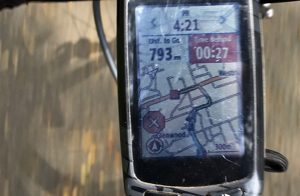 leaderboards; so in most cases you’ll always be looking to push yourself harder. Trust us when we say that there is nothing more motivating than seeing a virtual gap opening up in front of your eyes! There’s a bit of a process to get the segments onto your device, but once done, it all works beautifully barring a few glitches such as leaderboards not updating properly on your device, and the inability to switch off Live Segments during a ride. Minor issues that should get resolved by software update in due course. There is a downside though. You can kiss the chances of a non-competitive ride goodbye thanks to this feature!
leaderboards; so in most cases you’ll always be looking to push yourself harder. Trust us when we say that there is nothing more motivating than seeing a virtual gap opening up in front of your eyes! There’s a bit of a process to get the segments onto your device, but once done, it all works beautifully barring a few glitches such as leaderboards not updating properly on your device, and the inability to switch off Live Segments during a ride. Minor issues that should get resolved by software update in due course. There is a downside though. You can kiss the chances of a non-competitive ride goodbye thanks to this feature!
Additional leaderboards
There are two additional leaderboards available to Premium user: Age and Weight. This allows you to do an apples-for-apples comparison with other riders, but unless you are hell bent on getting to the top of a leaderboard, this feature doesn’t really add any value. At the end of the day, you’re out there racing everyone else at the same time, irrespective of their age or weight, so being at the top of the 65–74kg leaderboard is a bit of a shallow victory.
Suffer score
This feature provides a breakdown of the time spent in each of the major heart rate zones during your ride. A score is then calculated to give you an indication of how 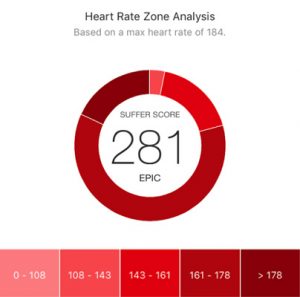 intense your ride was. It’s useful to sense check that your ride was aligned to your training goals, so if you set out to do an endurance ride, but you spent most of the time in the tempo region, you know you pushed too hard. Other than that, it gives you another dimension to compete with your mates – who’s actually suffered the most out there according to Strava Premium? This feature takes opinion out of the answer, and gives you an empirical measure to throw into your mates’ face. Kind of like the trump cards we used to play with as kids come to think of it! The screen grab is from a race we did in February. It pretty much sums up how we felt after 3 hours of intense suffering trying to make up lost time due to mechanicals.
intense your ride was. It’s useful to sense check that your ride was aligned to your training goals, so if you set out to do an endurance ride, but you spent most of the time in the tempo region, you know you pushed too hard. Other than that, it gives you another dimension to compete with your mates – who’s actually suffered the most out there according to Strava Premium? This feature takes opinion out of the answer, and gives you an empirical measure to throw into your mates’ face. Kind of like the trump cards we used to play with as kids come to think of it! The screen grab is from a race we did in February. It pretty much sums up how we felt after 3 hours of intense suffering trying to make up lost time due to mechanicals.
Power Zone analysis
Most of us average bros don’t have a power meter so Strava’s power estimations are the best we have to go on. The calculations do not take factors such as wind, ground conditions or gear selection into account so they’re not the most accurate, but they do provide a fairly consistent ballpark figure.
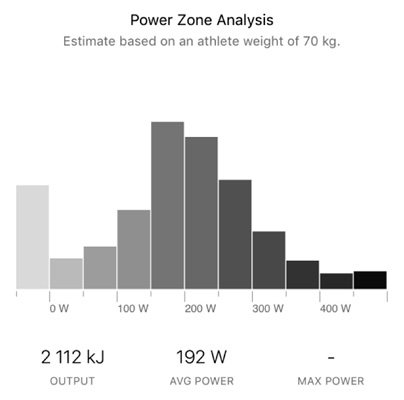
The power estimate for each segment you ride is shown by default for all users, but Premium users get a summary of the power distribution over the duration of the whole ride. Given that the power figures provided are estimates, it’s far from scientific, but it does give you an idea of the average power for the ride, as well as how long you spent in each power zone. Much like the Suffer Score, the biggest draw card here is to ensure that you spent the right proportion of time in each of the power zones. For example, if you went out to do some maximum threshold rides and your power distribution shows you spent the majority of your time in the middle bands, you’re doing it wrong.
Advanced segment comparison
Strava provides a ‘Compare’ function to enable all users to compare an effort on a segment to their previous best. Premium users can compare their effort against that of any other athlete, so if you’re at your wits end trying to figure out how people on the leaderboard are doing better than you on a particular segment, this is the tool for you. It’s really insightful to be able to see where the gap opens up, and how quickly it opens. Often you’ll find that there’s a particular stretch that you’re easing off the pedals while others are giving it 110%, so this definitely promotes awareness and helps push you to higher limits.
Goals
One of the features that we use quite a bit is the setting of goals. We follow a set training program, so for us, we have set weekly hours that we need to hit. Strava allows Premium users to set their goals for the week and/or year in the form of time (hours) or distance (km). You can quickly check to see how far you are from your goal, rather than having to do a mental tally each time you want to check. It also helps to see a visual representation of your progress, especially if you’re still miles off from the target four days in to the week!
Download GPX
If you want to upload rides to your GPS cycling computer to follow at a later stage, or share a route with a friend so that they can follow it, you’ll need to be able to get your hands on the GPX version of the route. Strava Premium users have access to export any ride to GPX format so that it can be uploaded to a GPS-equipped cycling computer. This functionality is however available on other platforms such as Garmin Connect, so it doesn’t really count as a competitive advantage for the boys in orange.
Training videos
There’s nothing more soul destroying than having to ride on an indoor trainer, staring at a wall for an hour or two. Strava Premium users can access training videos that have structured workouts that you can follow to help break the monotony of these sessions. We haven’t actually trained with them, but if this is your thing, we can see the benefit. The videos are based on actual cycling footage, with inserts from coaches to explain the workout structure, what’s required for each interval, and they also provide timers to let you know how long you have left in each interval and the workout.
There are a variety of videos to choose from depending on what your training goals are. It’s the next best thing to having a personalised coach barking at you from the front of the chamber. If you were stuck indoors that is…
Training plans
Strava has partnered with Carmichael Training Systems to provide you with customised training plans to help you achieve a specific goal whether it’s acing a 6-minute climb or completing your first Gran Fondo. They are tailored based on the number of hours you can put in, and there seems to be a good range of workouts thrown into the mix to help build different areas of your riding to help you achieve your goal. The plans are mailed through daily with a breakdown of the required workout for the day, an explanation of the daily goal and some tips from the coaching crew to help you get through it. If you’re new to training plans, these plans are a great place to start. They’re a little too generic for our liking though, but we’ve been around the block a few times so we’re quite particular about our plans.
Beacon
With Beacon, you can let people monitor you in real-time on your rides. This might not be the best feature if you’ve told your wife you’re going for a long endurance ride when you’ve actually made plans to ride to the coffee shop down the road with your mates. It is useful if you train on the roads, or you’re heading out into trails that you might get lost on. Loved ones will receive a message on their phone with a link to a page that allows them to see your position in real time, so if you’re taking longer than expected, they can easily see where you are and the pace that you’re moving. From this they can tell if all is ok, or whether you might need assistance. If it’s the latter, they have your exact position to head out to, or to pass on to the authorities. This feature is already available on some Garmin devices as ‘Live Tracking’, so it’s value in the world of Strava is dependent on whether your device already provides this functionality or not.
Heat maps
What should really be considered gimmicky is actually quite a cool visualisation of all those hours you spend in the saddle. The more you ride a route, the ‘hotter’ it becomes on the map, so you can use the heat map to visualize the terrain you cover, and how often you cover it. It’s not something you’ll use every day, or even every month for that matter, but it’s cool to check in out once in a while.
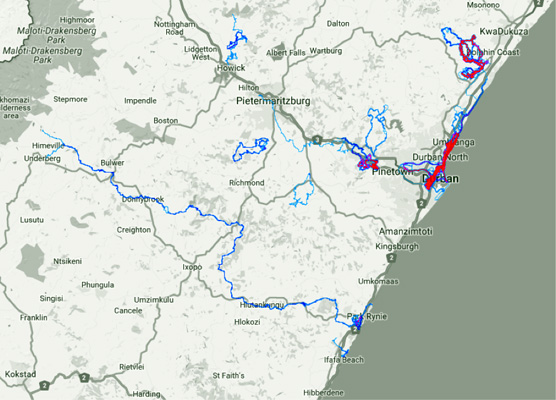
Fatigue vs Form
The aim of any decent training plan is to build fitness over time. This relies on gradually pushing yourself further and further, with the obvious drawback that you begin to fatigue over time. Fatigue is to be expected during training, but you want to arrive at races with maximum fitness and minimal fatigue. Strava provides a visual representation of the fitness-vs-fatigue relationship for Premium users. We’re not sure how they work it out, but you can see from this screengrab that it’s tracking pretty accurately over the past three months of hard training. This is incredibly useful information to have on hand to ensure that your tapering is going according to plan before the big race, so we’ll be watching these graphs over the next month or three to see if they remain accurate.
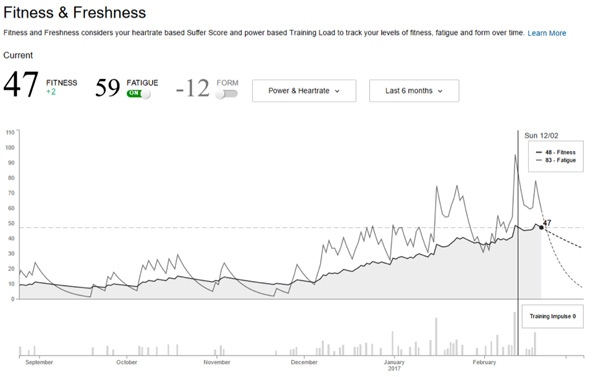
When you look at the Premium features, it’s clear that the folks at Strava have a good understanding of their user base. Their standard package is superb, and free, but they’ve gotten into the psyche of serious athletes to understand how they could expand on their base offering to monetise their platform. When you give away so much for free, it will take something special to get people to part with their hard earned cash in the interests of getting some additional functionality. So, is it worth it? In our opinion, Strava has hit the sweet spot. The additional functionality is by no means a showstopper for most, so we feel that the price is spot on. Anything higher than that will have the decision go from one made by the heart, to one made with the head, and we’re pretty sure that would lead to a rapid demise in the legions of Strava shield bearers.

All rights reserved


